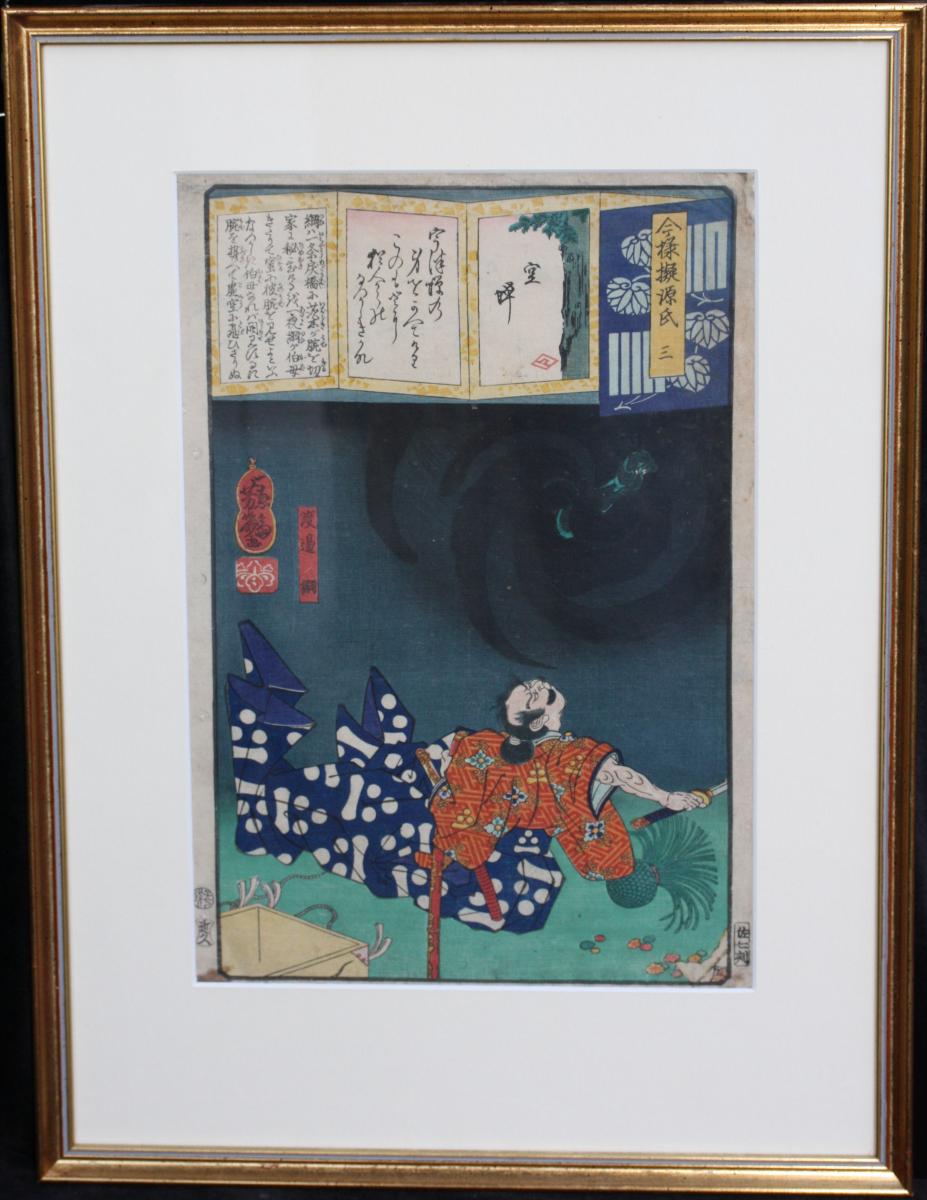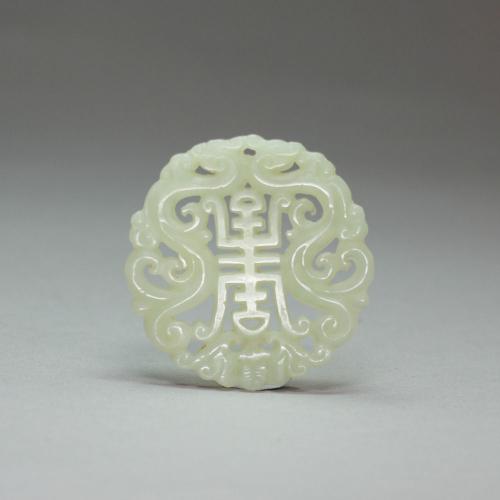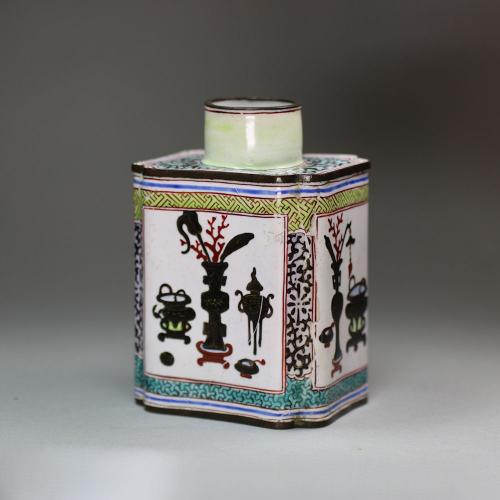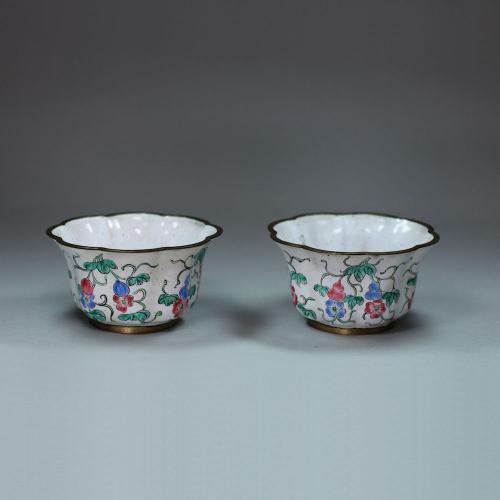

Price
£350.00This object is eligible for a Certificate of BADA Provenance
The BADA Standard
- Since 1918, BADA has been the leading association for the antiques and fine art trade
- Members are elected for their knowledge, integrity and quality of stock
- Our clients are protected by BADA’s code of conduct
- Our dealers’ membership is reviewed and renewed annually
- Bada.org is a non-profit site: clients deal directly with members and they pay no hidden fees
Framed Japanese polychrome nishiki-e woodblock print, 1864, by Utagawa Yoshiiku (1833-1904, also known as Ochiai Yoshiiku), ink on paper in vertical ōban format, signed ‘Ikkeisai Yoshiiku ga’ and with the artist’s paulownia seal as well as those of the engraver and the censor, depicting Chapter 3 from the series ‘Modern Parodies of Genji’ (今様擬源氏, Imayō nazaroe Genji), which is inscribed in the top right hand cartouche, below which the samurai Watanabe no Tsuna, seated upon a hilltop beside an open wooden casket, his sword drawn and gripped in his right hand, gazes up to the skies, where a supernatural dark spiral fills the night sky, a green and black severed arm at its centre; with inset letter-style panels at the top reading ‘Utsusemi’, (空蝉), linking the scene to a chapter of the Tale of Genji associated with a noblewoman of that name.
Prints from the same woodblock can be found in the collections of the Museum of Fine Arts Boston (11.39760) and the Rhode Island School of Design (85.197.2.)
Dimensions of print: 24.3cm. x 34.8cm. (9.1/2in. x 13.3/4in.)
Condition: Small areas of damage to edge of print.
Notes:
The artist has here linked two well-known Japanese tales in a subtle parody print. The first is a legend recounted in the Heike Monogatari and which features in numerous ukiyo-e designs of the Edo period. The legend is one involving the Heian period samurai Watanabe no Tsuna (953-1025), who, while a historical figure, also features as a protagonist in several supernatural tales and myths. Perhaps the most well-known episode is his defeat of the powerful oni (demon) Ibaraki Doji, who, according to the legend, dwelled in the Rashomon Gate in Kyoto and terrorised all who came near. Though the demon initially disguises itself, transforming into a beautiful young woman, eventually the two engage in a ferocious battle, during which Watanabe no Tsuna successfully cut off the demon’s arm; Ibaraki Doji fled, screaming in pain and leaving his severed arm behind. The arm was placed inside a casket and kept locked away. Later, an elderly woman visited the samurai, claiming that she was in fact his elderly aunt and would very much like to hear how he had vanquished the terrible demon. When Watanabe no Tsuna fetches the casket to show the severed arm, his visitor casts aside all disguise and reveals himself to be Ibaraki Doji, come to reclaim his arm before retreating once more. This is the scene depicted in the print, as told in the ‘Swords Chapter’ of the Heike Monogatari:
‘ “Ah, how horrible!” she exclaimed, looking at it again and again, “and so that is what a demon's hand is like.” And suddenly standing up, she became transformed into a horrible demon, and, crying out: “That is my hand ; I will take it;” she kicked out the gable of the roof and flew up into the sky, flashing fire as she went.’ (trans. AL Sadler, 1921 pp.331-332).
The connection between this historical legend and the 11th century Tale of Genji is not immediately obvious, but the inset cartouches at the top of the print link the scene specifically with the third chapter of Genji, 空蝉 (Utsusemi, ‘the shell of the locust’). In this chapter there are examples of disguise and also an instance where the lady Utsusemi ‘sheds’ her mantle, leaving it behind for Genji to claim in much the same way as the demon abandons its severed arm; these are just two possible links providing the basis for Utagawa’s playful connection of the two scenes.
Dimensions
Dimensions of print: 24.2cm. x 34.8cm. (9.1/2in. x 13.3/4in.)Condition report
Small areas of damage to edge of printStock number
R568The BADA Standard
- Since 1918, BADA has been the leading association for the antiques and fine art trade
- Members are elected for their knowledge, integrity and quality of stock
- Our clients are protected by BADA’s code of conduct
- Our dealers’ membership is reviewed and renewed annually
- Bada.org is a non-profit site: clients deal directly with members and they pay no hidden fees




